Crude Oil Pipeline Transportation System
Overview
Canada’s crude oil pipeline network has three different types of pipelines:
- Gathering pipelines move crude oil from the wellhead to storage and on to upgraders or refineries. Provincial regulators typically regulate these facilities.
- Feeder pipelines transport crude oil from storage tanks and processing facilities to transmission pipelines. Provincial regulators typically regulate these facilities.
- Transmission pipelines transport crude oil to refining markets, often across provincial or international boundaries. Transmission pipelines are typically regulated by the CER.
Figure 3. Crude Oil Pipeline System Overview
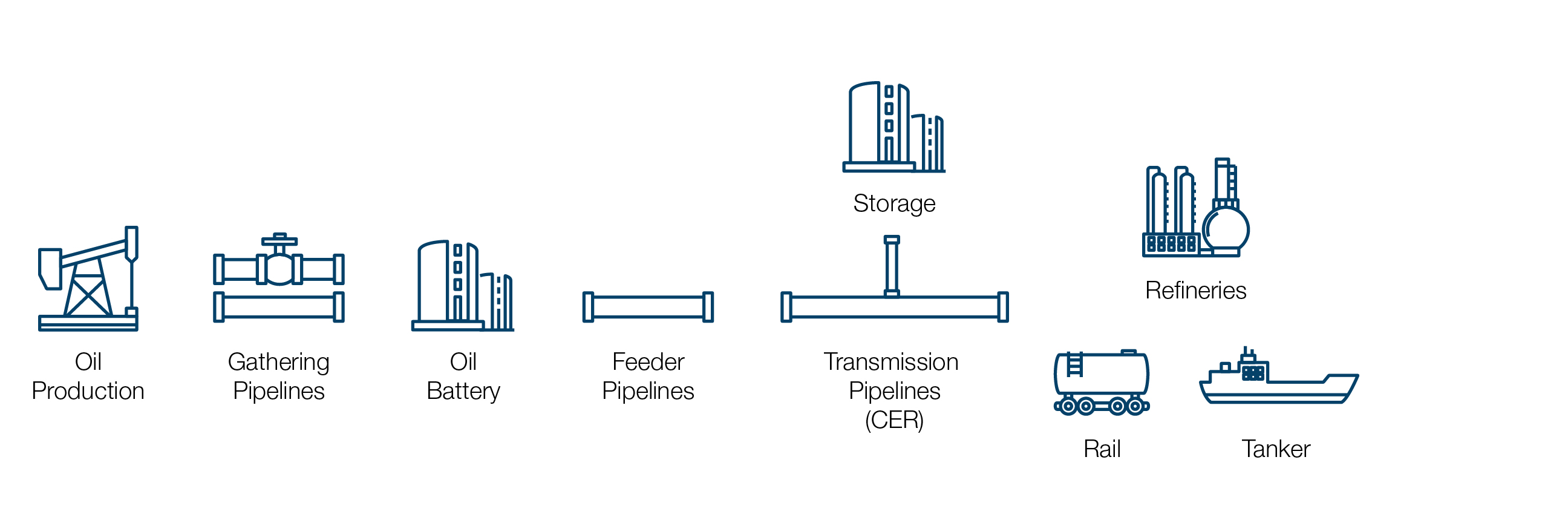
Source and Description
Source: CER
Description: This diagram provides an outline of the crude oil pipeline system from the point of production, through processing, transportation on feeder and transmission pipelines and ultimately to points of consumption (refineries) or exports (via rail or marine tanker).
Crude oil markets are complex, and different pipeline types can feed into different kinds of facilities. Also, storage and processing facilities can be located anywhere throughout the system to facilitate operations or increase efficiency.
If a pipeline crosses provincial or international boundaries, it is regulated by the CER. This report focuses on transmission pipelines because these are generally the ones crossing provincial or international boundaries. Typically, if a pipeline is contained within a province, it is under the jurisdiction of a provincial regulator unless deemed a federal undertaking.Footnote 2
The CER regulates approximately 68 000 km of operating pipelines, including 19 142 km of operating oil pipelines. The map below shows the major oil pipelines regulated by the CER.
Figure 4. Major CER-regulated Oil Pipelines
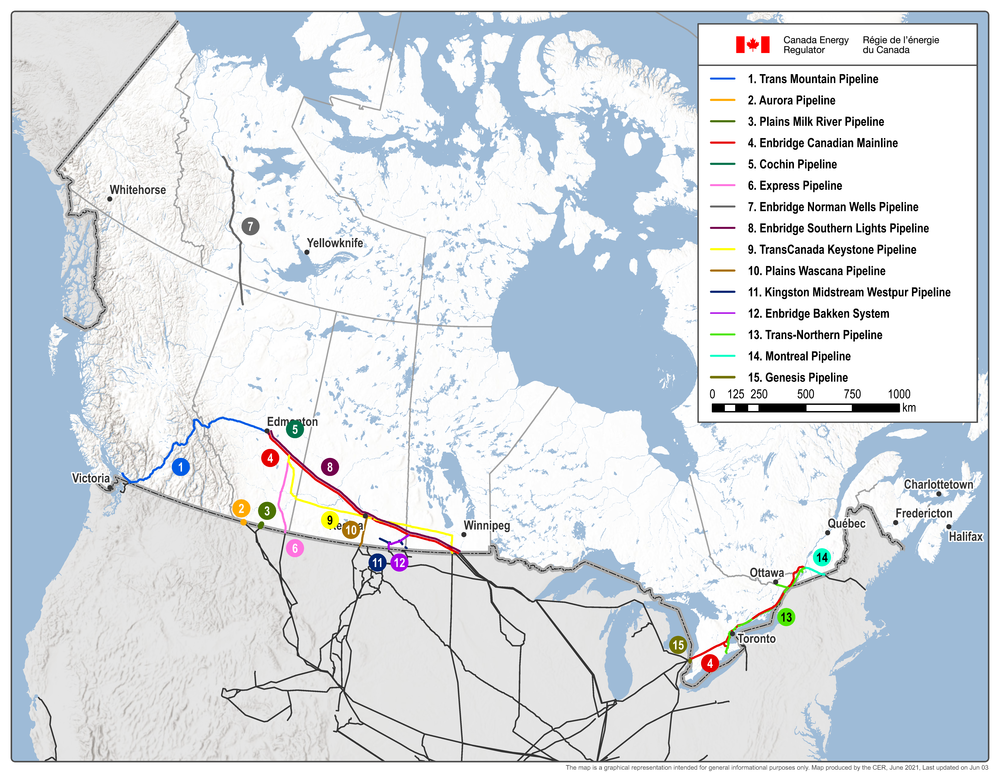
Source and Description
Source: CER
Description: This map shows the major CER-regulated oil pipelines.
Oil Markets
Canadian Supply and Disposition
In 2019, Canada was the 4th largest crude oil producer in the world, producing 5.9% of total global supply.Footnote 3 Crude oil production averaged 4.9 million barrels per day (MMb/d), or 784 thousand cubic metres per day (10³m³/d).Footnote 4 Production from the oil sands has grown 25% between 2015 and 2019, driving an overall increase in Canadian crude oil production.
Crude oil produced in Canada varies widely in quality. In general, light crude oil is more valuable to refiners because it produces a greater proportion of high-value transportation fuels. Heavy oil requires more processing and costly equipment, and produces a higher proportion of lower value products such as asphalt and fuel oil. As a result, light and heavy crude oil grades trade at different prices.
Much of the crude oil produced in Canada is heavy crude oil extracted from the oil sands in the Western Canada Sedimentary Basin (WCSB). Figure 6 shows the types of crude oil produced in Canada between 2015 and 2020.
The Western Canada Sedimentary Basin (WCSB)
The WCSB is an ancient, oil and gas-rich sedimentary basin 1.4 million square km in size that formed under southwest Manitoba, southern Saskatchewan, almost all of Alberta, eastern and northeastern British Columbia, and a small southern portion of Yukon and the Northwest Territories.
Figure 5. Western Canada Sedimentary Basin Map
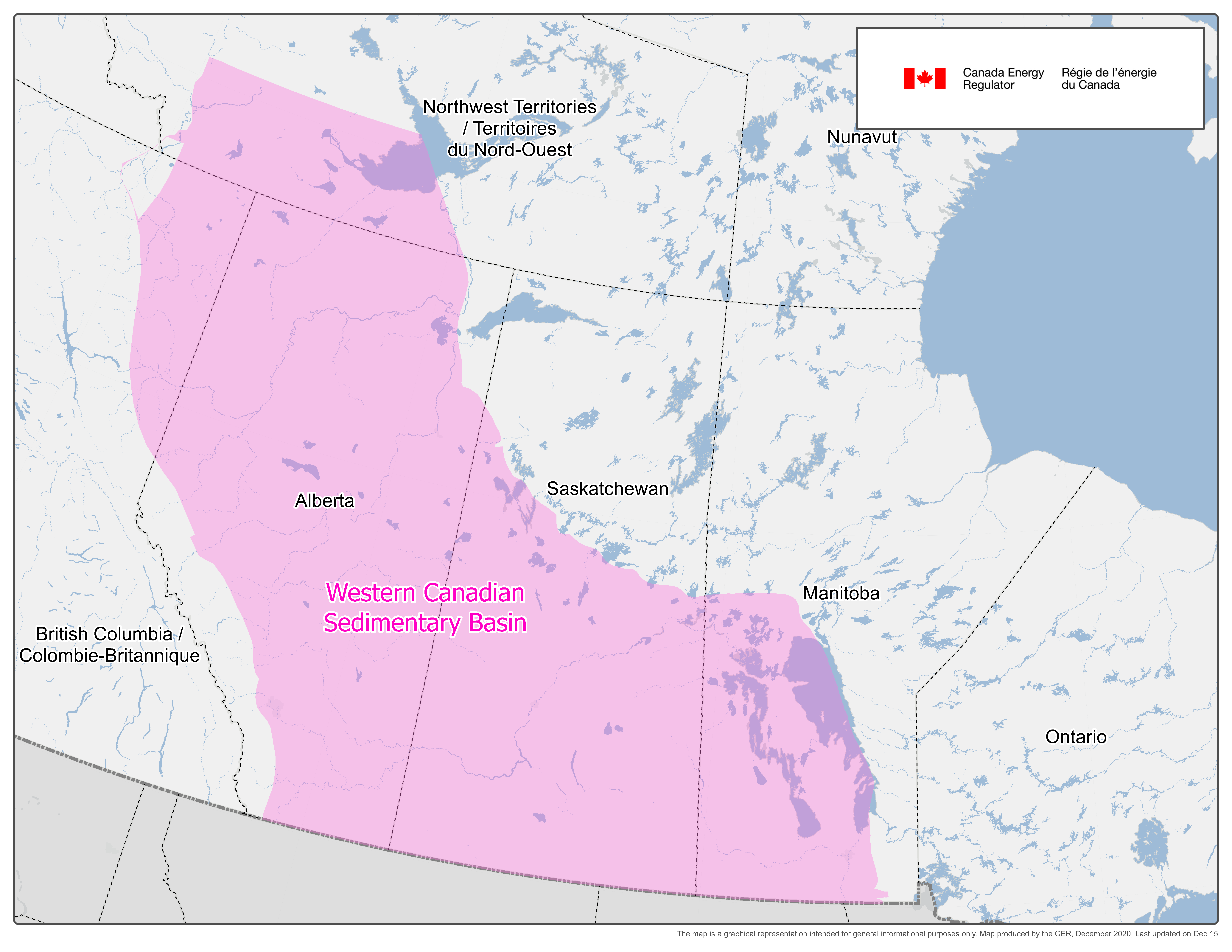
Source and Description
Source: CER
Description: This map shows the location of Western Canada Sedimentary Basin which the lower eastern part of Manitoba, the lower half of Saskatchewan, nearly the entire province of Alberta except the Rocky Mountains, a small section of north eastern British Columbia (B.C), and a section of the North West Territories north of Alberta and B.C.
Source and Description
Source: CER - Canada’s Energy Future 2020
Description: This graph shows crude oil production by type in Canada from 2015 to 2020. Over this period, crude oil production grew from 4.0 MMb/d (638.5 10³m³/d) to 4.6 MMb/d (730.6 10³m³/d). In 2020, in situ and mined bitumen made up 62% of crude oil production in Canada.
In March 2020 the onset of the COVID-19 pandemic led to a significant drop in global crude oil demand. This, along with a brief oil price war among some OPEC+ countries, led producers in western Canada to cut production by an estimated 972 Mb/d by mid-May 2020. Since then, global oil prices have recovered to pre-pandemic levels.Footnote 5 By January 2021, Canadian production had reached pre-pandemic levels.
Global and North American Crude Oil Markets

Most of the crude oil produced in Canada is shipped via pipeline from western provinces to refineries in the U.S., and in Quebec and Ontario. In 2020, Canada exported 82% of the crude oil it produced. The majority of this went to the U.SFootnote 6 and the remaining 17% was mainly refined within Canada.Footnote 7 Most Canadian refineries are not configured to process growing heavy crude oil from the oil sands, or may not have access to it. As a result, Canadian refineries in Ontario, Quebec, Newfoundland and LabradorFootnote 8 and New Brunswick import light crude oil.Footnote 9
Figure 7 below shows Canadian crude oil exports by destination, with U.S. exports grouped by the U.S. Petroleum Administration for Defense Districts (PADDs). The PADDs are geographic aggregations of the 50 States and the District of Columbia into five districts: the U.S. East Coast (PADD I), U.S. Midwest (PADD II), U.S. Gulf Coast (PADD III), U.S. Rocky Mountain Region (PADD IV), and U.S. West Coast (PADD V). In 2019, PADD II received 59% of Canada’s crude oil exports, and PADD III received 22%.
Source and Description
Source: CER - Commodity Tracking System
Description: This figure shows crude oil exports from Canada, by destination, between 2015 and 2020. Over that time period, the majority of the crude oil exported from Canada was exported to PADD II (U.S. Midwest). In 2019, PADD I (U.S. East Coast) was the smallest U.S. market for Canadian crude oil. Other refers to exports to countries other than the U.S.
The North American crude oil market has changed significantly over the past ten years. Horizontal drilling and multi-stage hydraulic fracturing has greatly increased light crude oil production from U.S. and Canadian shales and other tight formations.
Between 2015 and 2019, U.S. crude oil production grew 30%, from 9.4 MMb/d (1 496 10³m³/d) to 12.2 MMb/d (1 940 10³m³/d), and led to a reduction in U.S. imports of crude oil. Despite this, Canada’s exports to the U.S. grew from 3.0 MMb/d (483 10³m³/d) in 2015 to 3.8 MMb/d (599 10³m³/d) in 2019 and 3.4 MMb/d in 2020. This is partly due to declining imports from Venezuela and Mexico, two other suppliers of heavy oil to the U.S., during this period. Canada’s heavy oil does not compete directly with rising U.S. light oil production for refining markets. The lower demand for crude oil triggered by the COVID-19 pandemic led to a 12% decrease in Canadian exports in 2020 compared to 2019.
Source and Description
Source: CER – Crude Oil Export Summary, EIA – U.S. Exports by Country, and EIA – U.S. Imports by Country of Origin
Description: This figure compares U.S. crude oil imports by country of origin against U.S. crude oil exports. It shows a growing share of exports coming from Canada, which increased from 3.0 MMb/d in 2015 to 3.3 MMb/d in 2020. Over the same time period, U.S. total crude oil imports declined by 20%, from 7.4 MMb/d to 5.9 MMb/d. The figure also shows U.S. crude oil exports, which increased from 0.46 MMb/d in 2015 to 3.18 MMb/d in 2020.
Market Dynamics
Canadian crude oils compete in major markets therefore they are priced relative to crude oils in those markets. Since most of Canada’s crude oil is refined in the U.S., prices are often reported relative to the North American benchmark for light crude oil, West Texas Intermediate (WTI). Western Canadian Select (WCS), the most common Canadian heavy oil benchmark, is priced as a difference or differential to WTI, known as the WCS-WTI differential.
Two Major Components Contribute to Oil Price Differentials:
- Quality difference: based on API gravity and sulphur content. Heavy (high gravity) crudes are lower quality than light (low gravity) crudes because they yield a lower amount of high value end-products, like gasoline and diesel. Heavy crude oil is also more costly to refine compared to light crude oil. Similarly, sour (high sulphur) crudes are lower quality than sweet (low sulphur) crudes as sour crudes require additional refining steps and costs to remove the sulphur. Therefore, heavy crudes typically sell for a lower price than lighter crudes, and sour crudes sell for a lower price than sweet crudes.
- Transportation cost: reflects the additional cost to transport the crude oil to the major refining markets. Holding quality constant, crude oil that is physically located closer to major refinery regions will typically sell for more than crude oil located further from refineries.
Oil price differentials are affected by quality and transportation, as well as overall supply and demand, and general market sentiment. Meanwhile, pricing differentials between major markets can change based on availability of pipeline capacity. When pipeline capacity between two markets is adequate, commodity prices in these two markets will closely track each other.
As shown in Figure 9, WCS sells at a discount to WTI, reflecting the lower quality of WCS relative to WTI plus the cost to transport the crude oil to the U.S. Midwest market where WTI is priced. The U.S. Midwest and U.S. Gulf Coast are some of the largest markets for Canadian crude oil and therefore these markets determine the prices many Canadian producers receive for their production.
Source and Description
Source: NE2 Group
Description: This figure shows the WCS-WTI differential between 2015 and 2020. During that time period, the differential was the widest in October 2018, when it stood at US$43 per barrel. It was the lowest in March 2020, at US$7.90 per barrel.
Pipeline Capacity
All oil pipelines have a physical limit to the amount of product that they can safely carry. This is known as the pipeline’s nameplate capacity.
Available capacity is what a pipeline can actually flow. The available capacity of a pipeline typically differs from its nameplate capacity. This can be caused by various reasons, such as the type of crude oil being transported, unplanned outages, maintenance, downstream constraints, or pressure restrictions. Pipeline operators calculate how much product the pipeline can carry on any given day.
Pipeline design and operating pressure are subject to CER regulatory oversight under the Canadian Energy Regulator Onshore Pipeline Regulations (OPR). The design and operating pressure determine the capacity of a pipeline. Companies are responsible for meeting the requirements of the OPR to manage safety, security, and environmental protection through the entire lifecycle of their facilities. This lifecycle spans from the design to construction, operation, abandonment, and reclamation.
Balanced markets generally have sufficient pipeline capacity to allow for production to reach end markets. Too much spare capacity may increase tolls for pipeline shippers, and creates unnecessary infrastructure. However, inadequate pipeline capacity typically has significant costs, because if oil cannot be transported to market, producers and governments lose potential revenues. Sufficient pipeline capacity results in broader market access and more choices for market participants, along with increased market efficiency through competition among pipelines.
Generally, producers and other owners of crude oil prefer to transport their crude oil to the market where they can earn the highest netback price. When capacity is constrained, this may result in over-supplied local markets, causing local crude oil prices to decline relative to benchmark prices in other regions.
Between 2015 and 2020, the WCS-WTI differential averaged a discount of US$15.27 per barrel. The differential was exceptionally wide in the last quarter of 2018, at more than US$50 per barrel on some trading days in October. This was mainly caused by Canadian crude oil production exceeding the combined capacity of pipelines and crude by rail. The lack of sufficient transportation capacity made it more difficult to ship oil to markets/refineries, which lowered crude oil prices in Canada. Production limits imposed by the Alberta government, some better optimization of existing pipeline capacity, and an increase in crude-by-rail exports subsequently narrowed the differential to more typical levels.
Transportation Capacity and Utilization
Crude oil can be transported by pipeline, rail, truck, and marine tankers. Most of Canada’s crude oil exports are transported by pipeline, as shown in Figure 10.Footnote 10
Source and Description
Source: CER – Commodity Statistics
Description: The pie chart shows crude oil exports by mode of transportation for the years 2015 to 2020. In 2020, 87.6% of crude oil exports were transported by pipeline, 4.8% by rail and 7.8% by marine tanker.
Crude by Rail
Transporting crude oil by rail is more expensive than by pipeline and tanker. Rail is typically used when pipeline infrastructure is not available, or when price differentials are wide enough for rail to be economic. The differential that is required to justify shipping crude by rail varies by shipper.

Between 2015 and 2017, exports of crude-by-rail averaged about 110 thousand barrels per day (Mb/d) (17.5 10³m³/d). Crude-by-rail exports started to increase, averaging over 230 Mb/d (36.6 10³m³/d) in 2018. Pipeline capacity constraints out of western Canada and widening Canadian crude price differentials were the main reasons for the increase in crude-by-rail exports during this time.
In late 2018, to address historically wide differentials, the Government of Alberta imposed production limits for the province. This temporarily resulted in the WCS-WTI differential narrowing, and crude-by-rail volumes dropped in January 2019. Crude-by-rail exports started to ramp up again in mid-2019 and reached a record high of over 411 Mb/d (65.4 10³m³/d) in February 2020.
Since March 2020, the reduction in global crude oil demand due to the COVID-19 pandemic has significantly affected the Canadian oil industry. Producers voluntarily shut down production, easing pipeline capacity constraints on export pipelines. The WCS-WTI differential narrowed as a result and made crude by rail largely uneconomic. Since February 2020, crude-by-rail exports have declined to as low as 38.9 Mb/d (6.2 10³m³/d) in July 2020, and have increased since. In February 2021, they were at 111.8 Mb/d (17.7 10³m³/d).
Source and Description
Source: CER – Crude-by-rail Exports, and NE2 Group
Description: The combined area and line chart shows the volumes of crude oil exported by rail as an area chart and the WCS-WTI differential as a line chart. When the WCS-WTI differential increases, the volume of crude oil exported by rail generally increases. In 2016, the volume of crude oil exported by rail averaged 88 Mb/d (14.0 10³m³/d). It increased to 132 Mb/d (21.0 10³m³/d) in 2017, 231 Mb/d (36.7 10³m³/d) in 2018, and 273 Mb/d (43.4 10³m³/d) in 2019 before decreasing to 189 Mb/d (30.0 10³m³/d) in 2020. The WCS-WTI differential averaged US$12.51/bbl in 2016, US$12.26/bbl in 2017, US$26.81/bbl in 2018, US$13.59/bbl in 2019 and $US12.12/bbl in 2020.
Crude by Tanker

In 2020, 8% of Canada’s crude oil exports were by marine vessel (tankers). Oil tankers come in various sizes with larger vessels benefiting from greater economies of scale.
In Canada, crude oil is exported by tanker from the West and East coasts. Exports from Burnaby, B.C. are shipped to Asia and the U.S. West Coast. In Atlantic Canada, tankers are used to deliver offshore production to Europe and U.S. PADDs I and III. In 2016, marine exports averaged 202 Mb/d (31.1 10³m³/d). In 2020, marine exports averaged 279 Mb/d (44.4 10³m³/d). Figure 12 illustrates the growth in marine exports of crude oil from Canada.
Source and Description
Source: CER
Description: The area chart shows the volume of crude oil export by marine tanker. In 2016, the volume of crude oil exported by marine vessel averaged 202 Mb/d (31.1 10³m³/d). It increased to 214 Mb/d (34.0 10³m³/d) in 2017, 275 Mb/d (43.7 10³m³/d) in 2018 before decreasing to 262 Mb/d (41.7 10³m³/d) in 2019. Crude oil exported by marine vessel averaged 279 Mb/d (44.4 10³m³/d) in 2020.
Pipeline Capacity Utilization and Apportionment
Technical Background
Oil pipelines typically ship products in batches, because different commodities must be kept separate from one another to minimize contamination (ex. light crude oil, separate from medium, separate from heavy, separate from RPPs, etc.). For example, the Enbridge Canadian Mainline ships dozens of commodities, including some RPPs.Footnote 11 Shipping batches of various commodities increases the complexity of scheduling receipts and deliveries compared to moving a single commodity. However, systems have improved efficiencies by optimizing quality batching rules. All products are scheduled to a destination prior to injection into the pipeline.

Oil physically flows from producers to refiners in a variety of ways, and can be stored when required. Storage facilities can be found upstream near producing sites, linked to feeder and large export pipelines, or located downstream at refineries. Storage helps pipeline companies balance short-term supply and demand fluctuations on the pipeline network. Storage can also help other market participants maximize value for the crude by delaying delivery until buyers are ready for it, or when prices increase.
Transit time on pipelines varies depending on the destination. On the Enbridge Canadian Pipeline for example, a batch from Edmonton to Chicago will take 20 days to travel.Footnote 12
Table 1. Canadian Oil PipelinesFootnote 13 – Capacity, Contract Capacity and Uncommitted Capacity (June 2021)
| Pipelines | Total Current Capacity | Contracted Capacity | Uncommitted Capacity |
|---|---|---|---|
Enbridge Canadian MainlineFootnote 14 |
2 890 Mb/d |
0 |
2 890 Mb/d |
Express PipelineFootnote 15 |
310 Mb/d |
290 Mb/d |
20 Mb/d |
Milk River PipelineFootnote 16 Aurora PipelineFootnote 17 Wascana PipelineFootnote 18 |
97.9 Mb/d 45 Mb/d 40 Mb/d |
0 |
183 Mb/d |
Keystone PipelineFootnote 19 |
591 Mb/d |
555 Mb/d |
36 Mb/d |
Trans Mountain PipelineFootnote 20 |
300 Mb/d |
54 Mb/d |
246 Mb/d |
| Total | 4 274 Mb/d | 899 Mb/d | 3 375 Mb/d |
Source
Source: CER - REGDOCS, and company websites.
Table 1 shows the major CER-regulated oil and liquids pipelines and their capacities. The physical capacity of a pipeline is based on many factors, such as the products being carried, pipeline pumping capacity, and maintenance work or other pressure restrictions. The actual physical capacity of the pipeline may, at times, be higher than the assumed operational capacity stated in this table.
Most of the current capacity out of the WCSB is uncontracted/uncommitted. Generally, for uncommitted capacity, shippers request service each month by nominating volumes for delivery into the pipeline. If more volume is nominated than the pipeline can transport, then each shipper’s nominated volume is apportioned or reduced by the same percentage. Apportionment can be driven by growing oil supply, reduced pipeline capacity, and refinery maintenance or unplanned outages.
Apportionment is slightly different on pipelines with contracted capacity, but almost 80% of pipeline capacity out of western Canada is uncommitted capacity. This is because the largest pipeline, the Enbridge Canadian Mainline, has no contracts for capacity. It remains entirely uncommitted.Footnote 21
Other pipelines have contracts for capacity, though are still required to have some uncommitted capacity available to shippers to meet their common carrier obligations.
Source and Description
Source: CER, Canada's Energy Future 2020, and pipeline company websites
Description: This figure shows crude oil export capacity from the WCSB, and total supply available for export. The Enbridge Canadian Mainline makes up most of the export capacity, at 2.9 MMb/d (461.1 10³m³/d) in 2020. Total supply of oil available for export from this region was 3.6 MMb/d (578.7 10³m³/d) in 2020.
Western Canada’s four major crude oil export pipelines are the Enbridge Canadian Mainline, the Keystone Pipeline, the Trans Mountain Pipeline, and the Express Pipeline. The combined capacity of these four pipelines makes up 96% of all take away from the WCSB.
The Enbridge Canadian Mainline, owned by Enbridge Pipelines Inc.,Footnote 22 transports about 58% of all Canadian crude oil exports. It transports crude oil, RPPs, and NGLs within Canada. Available capacity on the Enbridge Canadian Mainline has increased from around 2.1 MMb/d (333.9 10³m³/d) in 2010 to almost 3 MMb/d (470.6 10³m³/d) in 2020. In 2020, 0.14 MMb/d (22.3 10³m³/d) of incremental capacity was added, mostly through pipeline optimization. The Line 3 Replacement Project in Canada and the Alberta Clipper (Line 67) expansion have also increased capacity on the Enbridge Canadian Mainline system. Further capacity will become available once the Line 3 Replacement Project’s U.S. portion comes into service.
On 13 November 2020, the State of Michigan notified Enbridge Inc. that the 1953 easement allowing it to operate Line 5 in the Straits of Mackinac is being revoked and terminated.Footnote 23 The notice, which Enbridge is disputing, requires Enbridge to cease operations of the dual pipelines in the Straits by 12 May 2021. On 12 January 2021, Enbridge issued a letterFootnote 24 stating that its review showed the State lacked the authority to terminate or revoke the 1953 easement. As of early June 2021, Line 5 continues to transport energy commodities. Enbridge and the State of Michigan are undergoing court ordered mediation to reach a resolution.
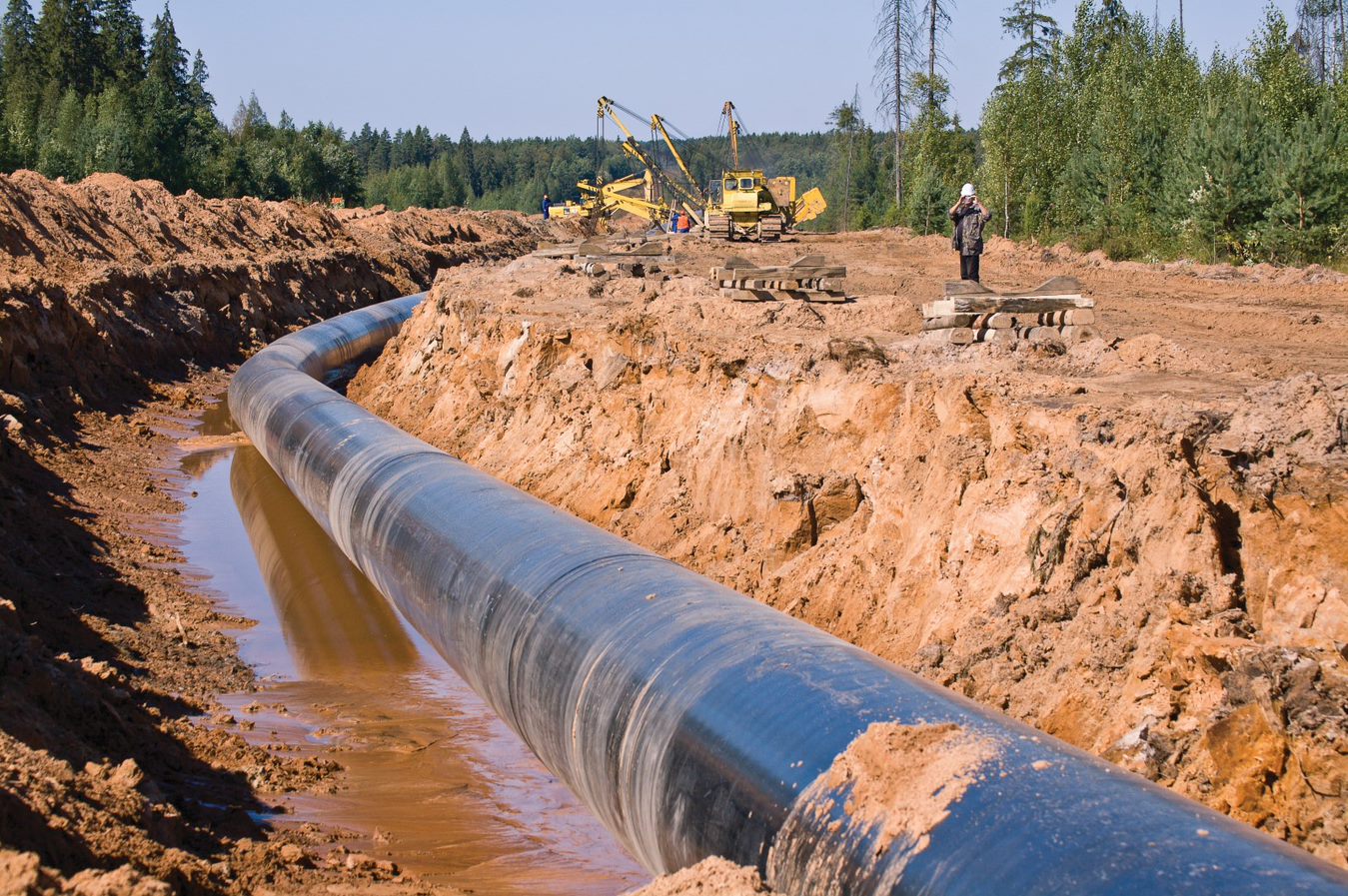
The Keystone Pipeline, an existing system often referred to as “Base Keystone Pipeline”, is owned by TransCanada Keystone Pipeline GP Ltd.Footnote 25 It transports about 14% of western Canadian crude oil exports to key U.S. refining markets. It has a current capacity of 580 Mb/d (92.2 10³m³/d) with long-term contracts for 495 Mb/d (78.7 10³m³/d), or roughly 85% of capacity. In July 2020, TransCanada Keystone Pipeline L.P. was granted a Presidential Permit on the Base Keystone Pipeline, which will allow an increase in the operating capacity of the U.S. portion of the Base Keystone Pipeline from 580 up to 761 Mb/d, which is the initial design capacity of Keystone.Footnote 26 Parent company TC Energy Corporation (TC Energy) also signed contracts for 50 Mb/d (7.9 10³m³/d) beginning in 2021.Footnote 27 The increase in operating capacity for Base Keystone Pipeline is separate from the Keystone XL project referenced in Table 2.
The Trans Mountain Pipeline, owned by federal Crown corporation Trans Mountain Pipeline ULC, transports refined petroleum products and crude oil to destinations in British Columbia, Washington State and Asia, via the Westridge Marine Terminal (Westridge Dock) located in Burnaby, British Columbia. The Government of Canada purchased the Trans Mountain Pipeline on 29 May 2018. The Trans Mountain Pipeline has a capacity of 300 Mb/d (47.7 10³m³/d). Contracted volumes (ie. long-term commitments) on the Trans Mountain Pipeline for delivery to the Westridge Dock are 54 Mb/d (8.6 10³m³/d).Footnote 28
The Express Pipeline (also known as Line 40A), owned by Express Pipeline Ltd.,Footnote 29 has a capacity of 310 Mb/d (49.3 10³m³/d) and delivers crude oil from Canada to Casper, Wyoming. From there, the Platte Pipeline, located entirely in the U.S, delivers crude into Ohio and Illinois. In April 2020, the CER approved the expansion of Express Pipeline capacity from approximately 287 Mb/d (45.7 10³m³/d) to 310 Mb/d (49.3 10³m³/d) with the installation of one prefabricated drag-reducing agent skid (a device to inject a chemical that reduces the resistance to flow) at the Express Hardisty Terminal. The project was placed into service in September 2020.
Proposed Pipelines and Expansions
Prior to the 2020 COVID-related production declines, major crude oil export pipelines were operating at, or near, capacity for several years, as incremental pipeline additions have not kept pace with supply growth. Despite some incremental capacity gains in recent years, industry is attempting to add additional pipeline capacity. Table 2 below shows crude oil pipeline projects proposed by industry in response to growing western Canadian oil supply.
Table 2. Proposed Pipeline Projects
| Proposed pipeline project (proponent) | Capacity increase | Original proposed in-service date | Expected date at full capacity | Contracted Capacity | Uncommitted Capacity | Status (as of June 2021) |
|---|---|---|---|---|---|---|
| Keystone XL (TransCanada Keystone Pipeline GP Ltd.) | 830 Mb/d |
2012 |
n/a |
500 Mb/d |
300 Mb/d |
U.S. permit revoked. |
| Trans Mountain Expansion (Trans Mountain Pipeline ULC) | 540 Mb/d |
2017 |
December 2022 |
707.5 Mb/d |
182.5 Mb/d |
Under construction. |
| Enbridge Line 3 Replacement (Enbridge Pipelines Inc.) | 370 Mb/d |
2018 |
Q4 2021 |
0 |
370 Mb/d |
Canadian portion in-service December 2019, U.S. portion is expected in 2021. |
Source
Source: Keystone XL, Trans Mountain, Enbridge, CER REGDOCS – Keystone XL and CER REGDOCS – Trans Mountain
Keystone XL Pipeline Project
On 11 March 2010, the National Energy Board (NEB, the Board) approved the Canadian portion of the Keystone XL Pipeline Project, which was intended to transport crude oil from Hardisty, Alberta to the U.S. Gulf Coast. On 20 January 2021, the U.S. presidential permit required for the completion of the project in the U.S. was revokedFootnote 31, and the project has been suspended.Footnote 32
Enbridge Line 3 Replacement Project
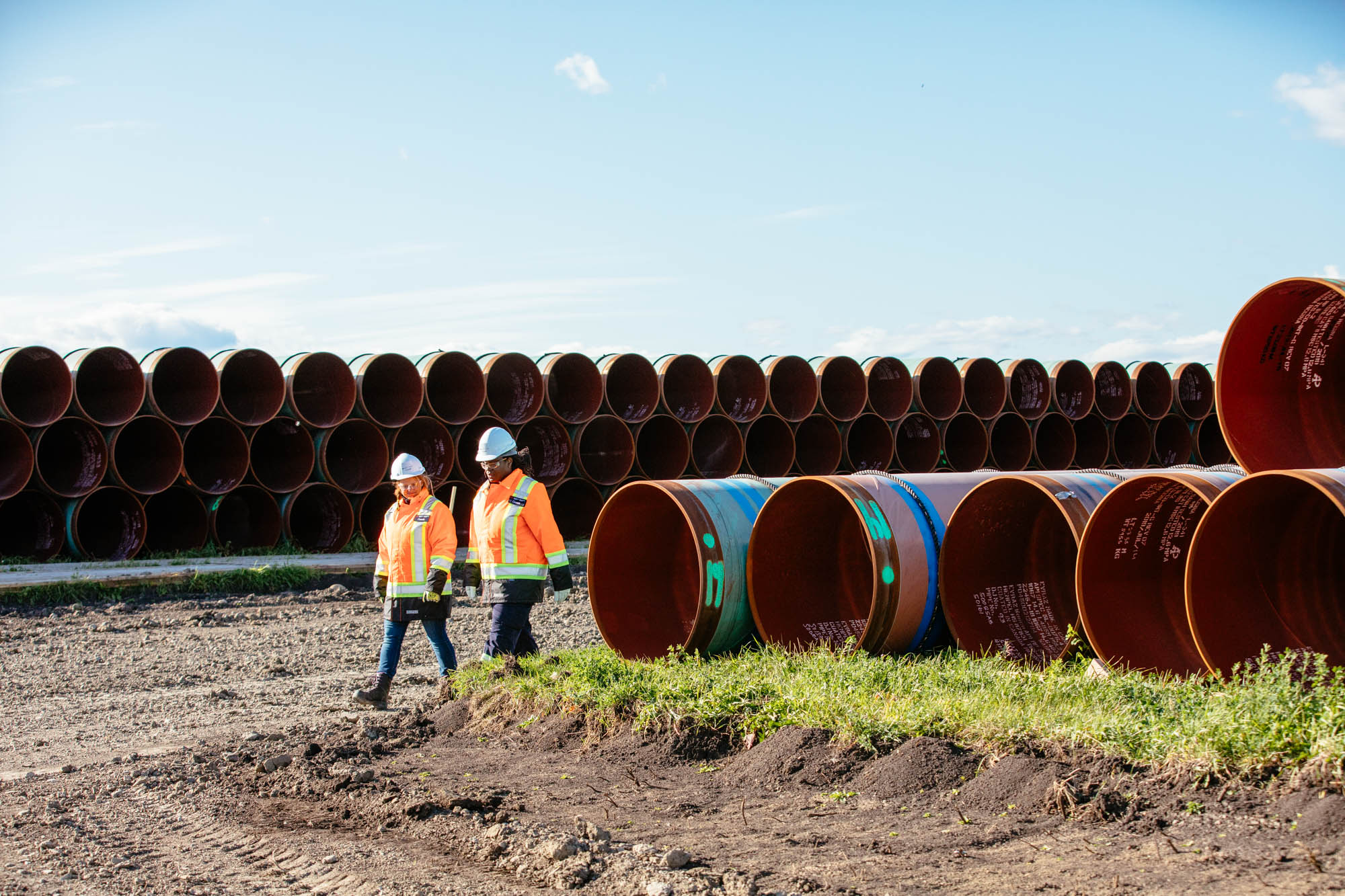
On 25 April 2016, the NEB recommended approval of the facilities application for the Line 3 Replacement Project. Line 3 is part of the Enbridge Canadian Mainline, which delivers crude oil from western Canada to the U.S. Midwest. The Line 3 Replacement Project is designed to allow Enbridge to replace the original Line 3 with a new pipeline that will operate at the original Line 3 design capacity of 760 Mb/d (120.8 10³m³/d), which is 370 Mb/d (58.8 10³m³/d) above the original Line 3’s more recent capacity. The Governor in Council approved the project on 25 November 2016.Footnote 33
The Canadian segment of the Line 3 Replacement Project is in service; however, because of bottlenecks downstream, only 40 Mb/d (6.4 10³m³/d) of the 370 Mb/d (58.8 10³m³/d) capacity can be used.Footnote 34 The remaining capacity will come online when the U.S. Line 3 replacement Project has been completed. The U.S. segment is not expected in-service until the end of 2021.Footnote 35
Trans Mountain Expansion
On 19 May 2016, the NEB recommended approval of the Trans Mountain Expansion Project (TMEP) facilities application. The Governor in Council approved the expansion on 29 November 2016; however, the Federal Court of Appeal overturned the approval on 30 August 2018, directing the NEB to reconsider the project-related impacts of marine shipping.
The Board issued its reconsideration report (MH-052-2018) in February 2019, and the Governor in Council approved the project for a second time on 18 June 2019.Footnote 36
The TMEP will serve markets in British Columbia, Washington State, California, and Asia. The project will increase the capacity of the existing Trans Mountain Pipeline from approximately 300 Mb/d (47.7 10³m³/d) to 890 Mb/d (141.5 10³m³/d). The TMEP has long-term contracts for 708 Mb/d (112.3 10³m³/d) for 15 to 20 years. The expected in-service date is December 2022.Footnote 37
- Date modified:
